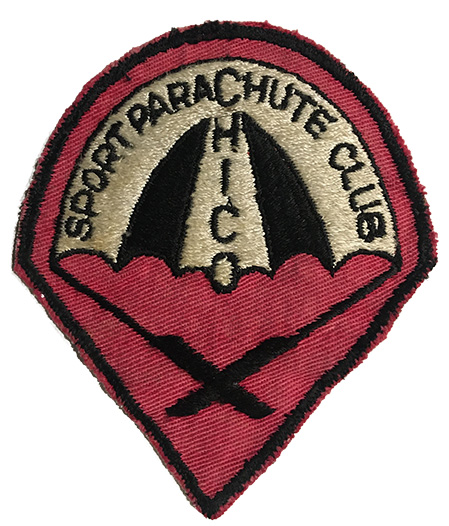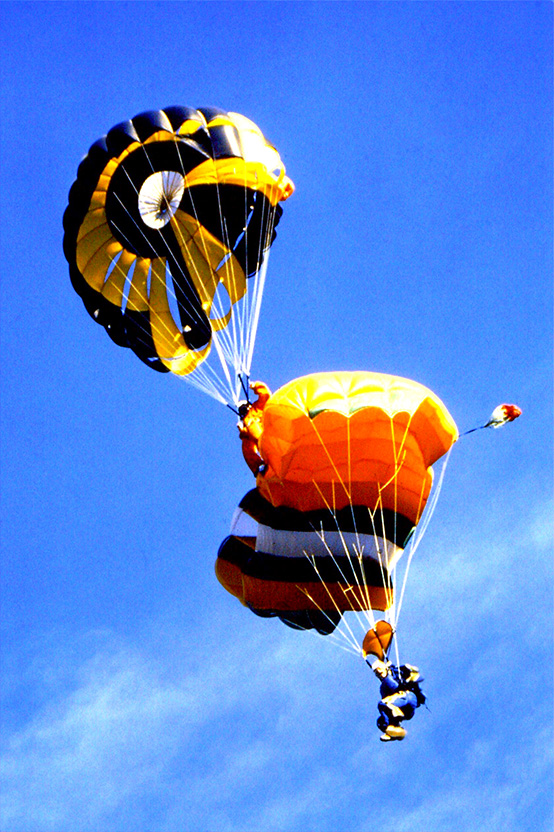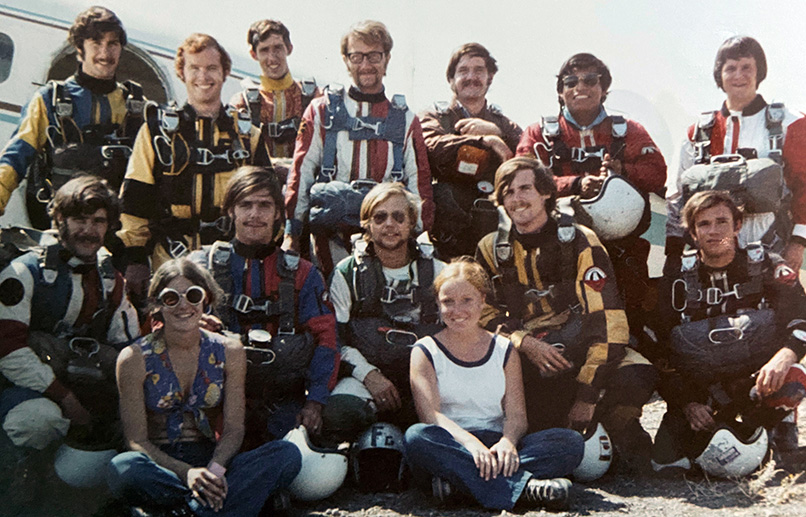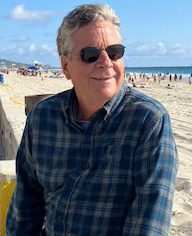 Above: CSPC members build an 8-stack at Pope Valley, California, in 1978. Photo by Wes Green.
Above: CSPC members build an 8-stack at Pope Valley, California, in 1978. Photo by Wes Green.
Toward the end of 2023, 16 longtime skydivers gathered in Yuba City, California, to celebrate more than 50 years of the Chico Sport Parachute Club, one of the first parachuting organizations in Northern California. CSPC’s unofficial historian and secretary Sue Eubanks organized the event, where she and fellow members and plus-ones Sally Carter, Dennis Cooper, Chuck Drake, Wes Green, Lilli Johansen, T.J. McGrath, Jim Murrell, Steve Nicholson, Dave and Carol Rudolph, Bob and Margaret Scott, Maureen and Monty Stephens, Wayne and Debby Stephens, John Wilson and Noah Wilson celebrated five decades of friendship and the common bond of skydiving.
The exact origin of the Chico Sport Parachute Club is lost to time, but older jumpers in the area recalled that it began in approximately 1956, had an operational drop zone and was affiliated in some manner with Chico State College. There was sporadic jumping at the location, but at some point in the mid-’60s, the club became inactive.
That all changed in 1968, when Chico State student Wes Green, who had been jumping in Calistoga, California, convinced his roommate, John Wilson, to begin skydiving. Wilson trained at the drop zone in Lake Elsinore, and the pair soon decided that they’d like somewhere local to their college to jump. Enter fellow student Bob Scott, D-714, who told them about the previous club. They located a few former CSPC members and began organizing.
First up: find a drop zone, pilot and jump gear. Fortunately, Scott knew Perry Stevens, owner of Stevens Para-Loft in Oakland, who outfitted the group with four surplus military rigs with mains and reserves, static lines and other equipment. The club was also able to acquire the use of the previous drop zone, the Oroville Mat, an old World War II training site for the Army Air Corps. CSPC advertised in the college newspaper for students: training and a static-line jump for only $10! The first class of 40 students trained for six hours, practicing exits out of a VW bug, drilling parachute landing falls off a 4-foot-tall platform and learning canopy flight and landing in the hanging harness (aka “the Hanging Agony”).
The Relative Work Years: 1969–1974
 Bill Blackburn and Don Cingrani fly a mixed round/ram-air canopy formation. Photo by Wes Green.
Bill Blackburn and Don Cingrani fly a mixed round/ram-air canopy formation. Photo by Wes Green.In the late ’60s, club members began jumping the new Para-Commander canopies, which were a big improvement over military rigs with better steerability and softer landings. Soon, they began using newer parachute designs such as delta wings and then ram-airs. The focus of the club also turned to relative work (now called “formation skydiving”). To take advantage of their larger planes, the jumpers would often visit the drop zones at Calistoga and Yolo, where they could build the bigger 8- and 10-way formations.
Due in part to training students at the club’s own drop zone, by the early ‘70s, CSPC membership had grown to about 30 regular jumpers. However, the location bounced around—from Oroville, to Pence Road, to Vina (another old World War II training site)—until it finally landed at a permanent location in Corning in 1974.
The Corning airport was a perfect location: close to town with indoor training facilities and restrooms. (Yay for flush toilets!) The nearby town provided easy access to restaurants, overnight lodging and a famous liquor store. The latter was particularly useful, since an unwritten rule of the club required every student on their first freefall to provide a case of beer (usually Coors) for the rest of the club. Corning was also infamous for its August heat, when temperatures rose to 110 degrees. Fortunately, jumpers could cool off at the nearby Sacramento River.
Exhibition and Canopy Relative Work Years: 1974-1987
During the late ‘70s through the mid-’80s, the club gained a higher profile both inside and outside the parachuting community, and its reputation grew. Members made several exhibition jumps into annual events such as the Redding Sports and Boat Show, the Redding Airshow and Shasta College football games. The Santa Claus jumps were particularly popular.
The late Tom Courbat introduced canopy relative work to the club in 1977. Courbat was instrumental in organizing the Know-SenseCRW team, which made what the club believes was the first 8-stack canopy formation on October 23, 1977. That jump, made in Livermore, California, was filmed and photographed for the National Enquirer. Courbat also created the Canopy Crest Recipient and Canopy Crest Soloist awards program, which USPA eventually purchased from him.
What really put the club on the map for Northern California jumpers were the annual Chico Freako Fallies, which started in the mid-’70s. The boogies featured larger aircraft—at first, three Twin Beeches; then a DC-3; and finally, a Twin Otter—as the drop zone gained in popularity.
Jumping continued at the Corning drop zone until 1986, when jumpers moved away from the area to find careers. But they never forgot one another. The tight-knit group holds reunions regularly, both in Chico and in other locations such as the Reno Air Races. At the most recent event in Yuba City, the group toasted the friends who are no longer with them but are always in their hearts: Bill Blackburn, Sandy Borchert Drake, Tom Courbat, Fred Geijsbeek, John T. Guice, Ron Hughes, Dave Matthews, Jeff Stadheim and Jeff Steele. They also swapped many tales of skydives and other shenanigans, with perhaps just a few embellishments.
Summing it up, club member John Wilson said, “The friends, experiences and adventures, in retrospect, seem magical and almost surreal. Much of it would have evaporated with the passage of time. Our reunions secured that magical period of time into a living tapestry of so many precious memories.”

CSPC members gather for a group photo at the Yolo, California, DZ circa the early 1970s.

Club members gather for a group photo at the 2023 reunion.
 About the Author
About the Author
Wes Green, D-7508, revitalized the Chico Sport Parachute Club with his roommate, John Wilson, in 1968. He made more than 1,000 jumps during his 29 years in the sport, one of which was as the photographer for the first-known 8-stack canopy formation. He was also an FAA Senior Parachute Rigger and Private Pilot. He is now retired and lives in Yuba City, California.